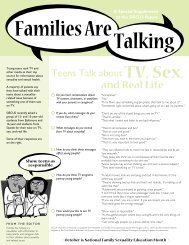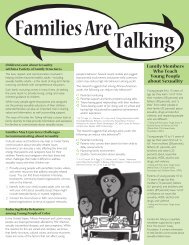What Is Normal Childhood Sexual Development? - Sex Ed Solutions
What Is Normal Childhood Sexual Development? - Sex Ed Solutions
What Is Normal Childhood Sexual Development? - Sex Ed Solutions
- No tags were found...
Create successful ePaper yourself
Turn your PDF publications into a flip-book with our unique Google optimized e-Paper software.
Ages 9 to 12 Ages 3 to 8COMMON BEHAVIORS *Children Ages 3 to 4 may:• Become increasingly curious about their bodies.Knowing that touching their genitals feels good, theymay begin to masturbate by stimulating themselveswith their hand or rocking against a stuffed animal,which may or may not lead to orgasm.• Establish that they are a boy or a girl. However,while playing they may pretend to be the othergender.• Be inquisitive about body differences and voluntarilyplay house, doctor, or explore other forms of sexualplay with friends or siblings that are close in age anddevelopmental level. If they play alone, they mightundress their dolls to see their genitals.• Express interest in words associated with bathroombehaviors, show curiosity about how males andfemales use the toilet, repeat “curse” wordsthat they hear, and start to ask sexuality-relatedquestions like “Where did I come from?”COMMON BEHAVIORS *Children Ages 5 to 8 may:• Continue sex play and masturbation.• Become very curious about pregnancy and birth.• Form strong same-sex friendships. Girls tend toform close intimate bonds with one or two othergirls. Boys usually play in larger groups and theirplay is usually oriented around activities.• Show strong interest in stereotypical male andfemale roles, regardless of parents’ approach tochildrearing.COMMON BEHAVIORS *Children Ages 9 to 12 may:• Become more modest and desire privacy as they beginpuberty.• Be more curious about developed male and female bodies.• Look at erotic magazines and Internet sites.• Develop romantic crushes on friends, older teens,celebrities, and other people that play a role in their lifelike a teacher, coach, or counselor.• Show an interest in dating.• Wonder “Am I normal?” and compare themselves to others.• Experience pressure to conform to family and societalexpectations of appropriate behavior for boys and girls.• Use sexual language and explore romantic and sexualfantasies.• Masturbate to a deeper, more adult-style orgasm.How Parents and Caregivers CanFoster the <strong><strong>Sex</strong>ual</strong> <strong>Development</strong> ofTheir Children Ages 3 to 8:• Explain in a calm tone that while touching the genitalscan feel good, it is to be done in a private place like theirbedroom.• When finding a child engaged in sex play with another child,gently ask them what they are doing so that thescenario can be understood from the child’s perspective. Itis important to remove the adult lens and see the behaviorfrom the child’s point of view.This will help parents understandthat more often than not, the behavior is not eroticallyfocused but motivated by curiosity.• Parents can then explain that one’s penis/vulva/buttocks etc.are considered to be private, and that no one should touchtheir “private parts” except for health reasons or to cleanthem.• Give the child anatomically correct dolls to help them understandthat girls and boys have many body parts that are thesame and some that are different.• Read age-appropriate sexuality books with the child to helplay the foundation for them to grow up sexually healthy.• Continue to model appropriate behavior and share positivemessages about gender and other aspects of sexuality thatarise.• Use proper terms to name body parts, including the genitals.• Follow up children’s questions age-appropriately by askingquestions like “<strong>What</strong> do you think?” This will give parents anidea of what they are really asking and help give an indicationof what they are ready to learn.How Parents and Caregivers CanFoster the <strong><strong>Sex</strong>ual</strong> <strong>Development</strong>of Their Children Ages 9 to 12:• Respect the pre-teen’s desire for privacy.• Share family values about dating and love.• Help pre-teens develop decision-making,communication, and assertiveness skills.• Continue to model appropriate behavior and sharepositive messages about sexuality-related issues.• Continue to answer pre-teen’s questions and sharemessages about various topics and family values.• Give the pre-teen age-appropriate sexuality books.• Let the pre-teen know that they have support.
















